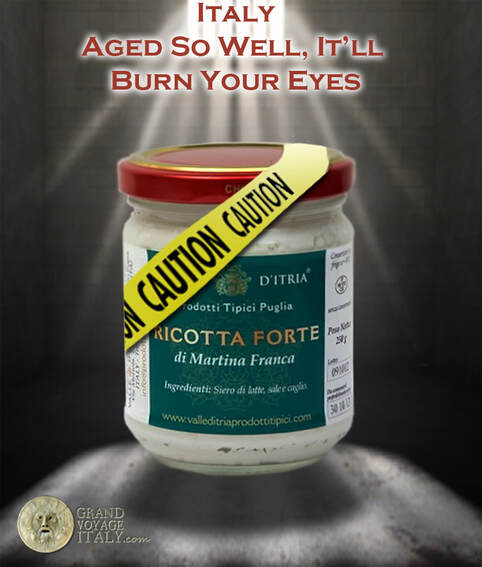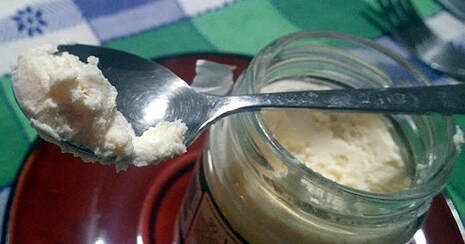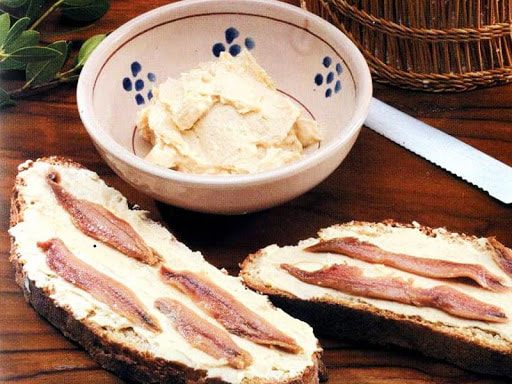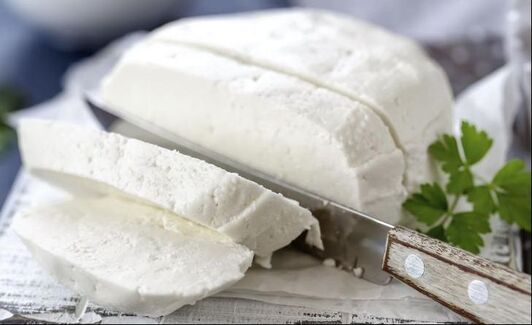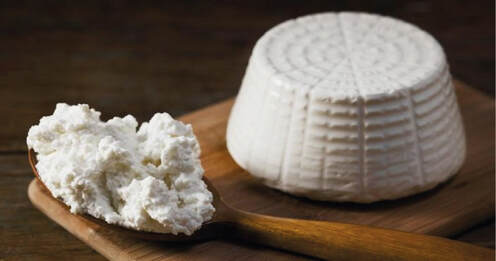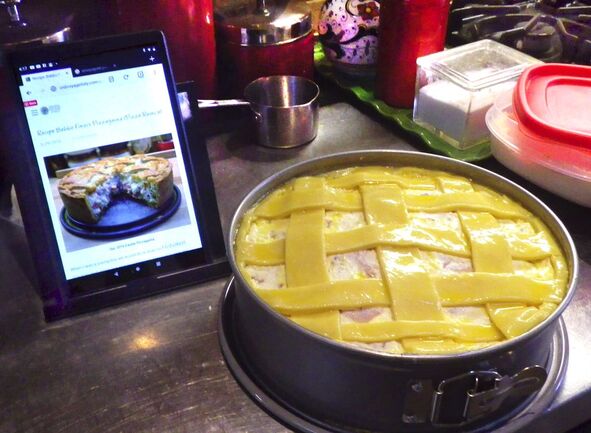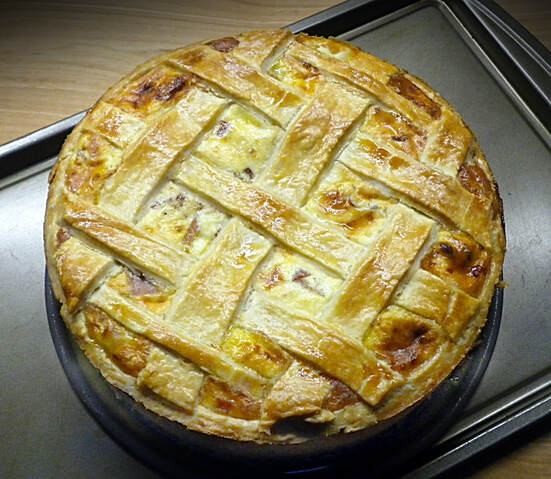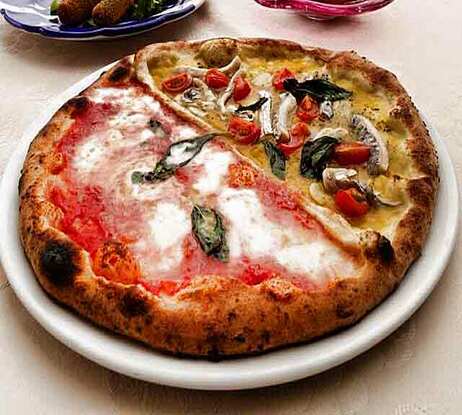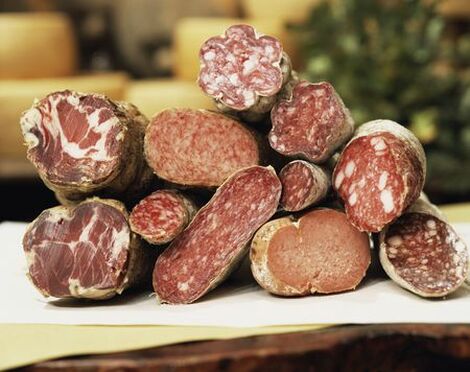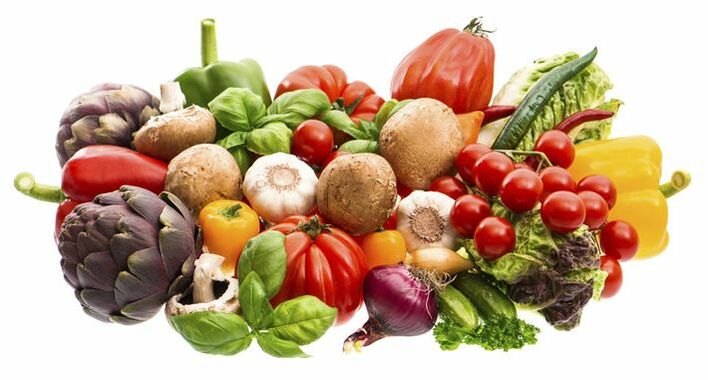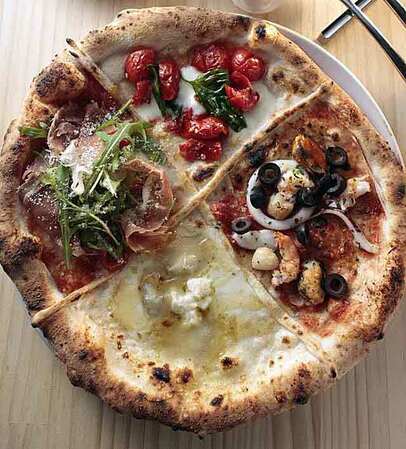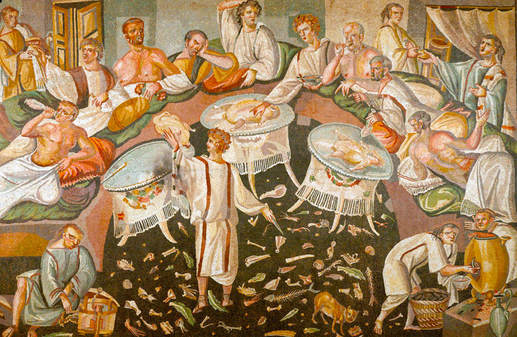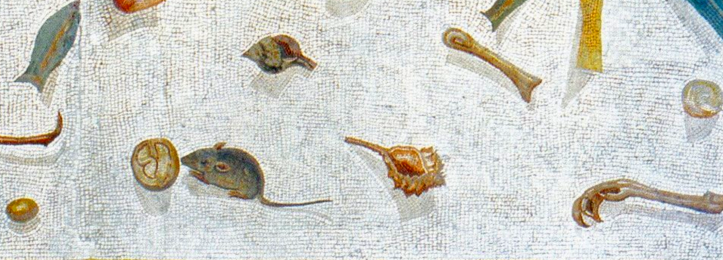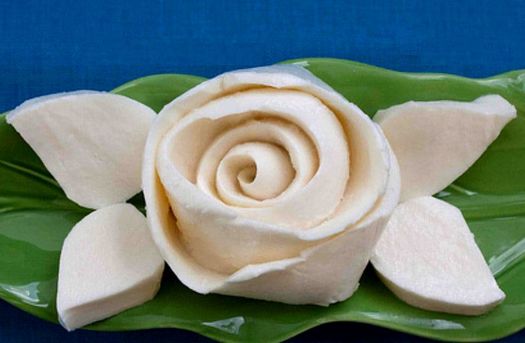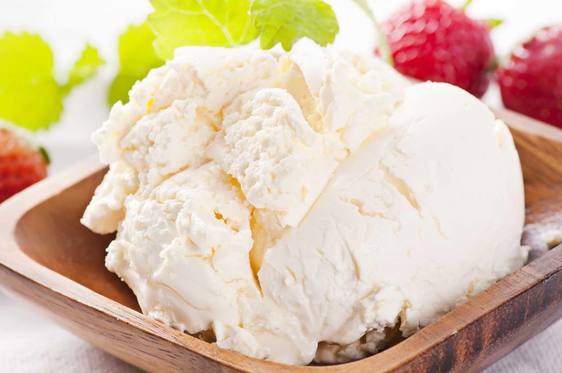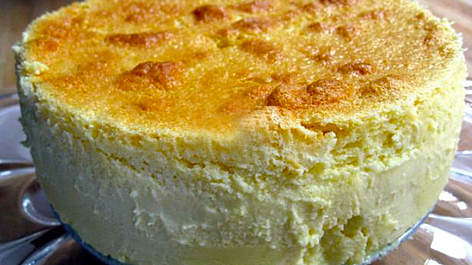 Lucas at 11, surviving the tasting of this evil cheese Lucas at 11, surviving the tasting of this evil cheese Ricotta forte is a traditional Apulian cheese, typically made at home under the kitchen sink or in a dark cantina (cellar), although can be found in supermarkets in Italy. Found in both Puglia and Basilicata, it might also be called Ricotta scanta, 'scante, scanta, ascuante, or "ashquant" in local dialects. Initially, it is made in the same way as ricotta, but using a strong flavored milk such as goat or sheep. The texture is similar to cream cheese, usually with an off-white color. It's definitely a cheese that spreads easily. The aroma coming from this cheese is not for the faint-at-heart, as we can attest to when confronted with ricotta forte one morning at a trullo bed & breakfast near Alberobello. One sniff snapped our heads back, but we spread it on our toast anyway, our host drizzling some honey on top, then we tasted... To be honest, it reminded me of when I was a kid and out bread developed mold, but that was bland compared to this stuff. The flavor is sharp as a Neapolitan criminal's stiletto, pungent, sour, bitter, with an intensity that burns your nostrils. This cheese is a total assault on your palette. Our eyes snapped open and then teared up. I got some on a sweet pastry sitting on my plate and later on when I bit into it, the whole sweet taste was ruined. It took literally an hour or two for our taste buds to relax back to normal. Many Pugliese still make this cheese today, a remnant from the days when shepherds came up with this devilish bastardization of the ricotta we all know and love. They placed the freshly made ricotta into small ceramic or glass jars, sprinkled with sea salt, then placed it under their sink or other dark place. A few times each week the lid is removed and stirred in a process that lasts for 3 months. As it matures it grows a fungus which gives this a flavor with more kick than any blue cheese you've ever tasted. It's a regional specialty that locals enjoy spreading on warm crostini, either plain or drizzled with honey or balsamic. In my opinion, it contrasts too much with sweet things like figs or grapes, but tomatoes and other savory items like anchovies are a better match. Watch the following video to learn how Ricotta Forte is made. It's in Italian with Italian text, but if you remember the words giorno (day) and mesi (months) you'll figure out how to make it and the time period intervals involved. In case you'd like to try it yourself, here is one place you can buy a jar. Enjoy! --Jerry Finzi Most Italian-Americans have heard of basket cheese, that light, soft, fresh cheese (similar to ricotta) sold in Italian specialty stores every Easter which is used to make the traditional pizzagaina or pastiera di grano (wheat grain pie) recipes. In the U.S. it is rarely seen year-round and is mostly used as an ingredient. In Italy, basket cheese is is called formaggio fresca (fresh cheese) and is readily available all year long for use as both recipe ingredient and as a table cheese, just as ricotta is eaten, but with a less salty and milder flavor. 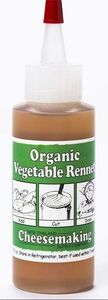 Basket Cheese Ingredients 1 gallon whole milk (or, if you can find some, use goat's milk) 1/4 teaspoon rennet 1/4 teaspoon salt (basket cheese is less salty than ricotta) You will need: Directions
You can now use your basket cheese fresh as an ingredient in recipes, such as the traditional Easter pizzagaina. If you want to eat it fresh (the same day is best) you can turn the baskets upside down onto a serving plate and remove the basket. This is a mild cheese, but if you like you can sprinkle with a little sea salt or fresh ground pepper. You can also spread it on bread or crostata and drizzle with honey or balsamic and serve with with figs or fresh berries. Although it should be eaten the day it's made, you can keep it for several days by keeping the basket in a plastic container along with with an inch of milk. 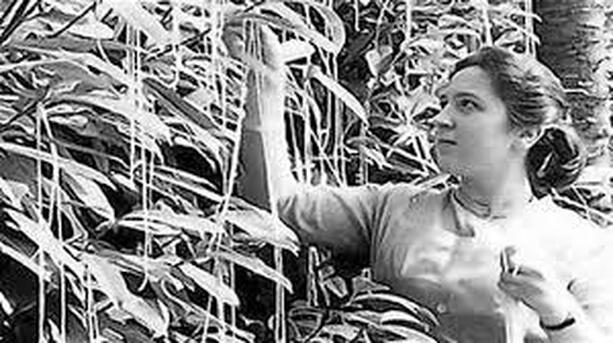 Making Ricotta from the Leftover, Fresh Whey Although my wife Lisa's ricotta recipe is great, technically, it's not a true ricotta made from whey. Making true ricotta (re-cooked, or cooked twice) is incredibly simple once you have whey leftover from cheese-making using rennet. The whey has to be fresh from the cheese-making process above.
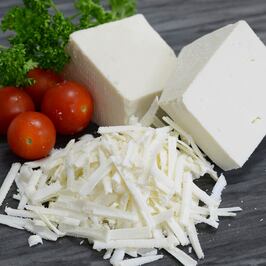 Making Ricotta Salata Ricotta salata is basically a firm, saltier version of ricotta cheese that is very similar to feta. While feta is made with rennet, ricotta salata is made from the whey leftover from cheese-making, just as normal ricotta is made. Ricotta salata needs more salt than normal ricotta and is pressed it to release any extra moisture. You need a fine mesh cheesecloth or butter muslin.
Ricotta salata is beautifully paired with sliced apples, pears, fresh figs or crumbled on pizza, pasta or salads. Buon apetitto! --Jerry Finzi You might also be interested in...
Southern Italian Pastries: Pasticiotti versus Pasta Croce Recipe: Babbo Finzi's Pizzagaina (Pizza Rustica) Recipe: Lisa's Home Made Ricotta Cheese Ricotta: Twice Cooked and Not Quite a Cheese? Recipe: Sicilian Ricotta Cheesecake Making Fresh Giuncata Cheese 31 Italian Cheeses: Goat, Cow, Buffalo and Sheep, Oh My! Supermarket Parmesan Cheese Contains Cellulose: Not All That it's Grated Up to Be? Marscarpone: More than Just Italian Cream Cheese This year we decided to make our Pizzagaina recipe once again. We loaded up my Kindle with our recipe on GrandVoyageItaly.com and got started getting the ingredients together. As usual, my son Lucas helped with the mise en place. He is a great sous chef but nowadays is also cooking a lot of his own dishes.
With the coronavirus limitations of shopping, and certain things in our fridge missing, we decided to use up some smoked gruyere in place of the mozzarella but still used ricotta and fontina (I love its creaminess). That's the way of the Italian cucina--not letting anything go to waste. Otherwise, our recipe was the same. And each time I make this treat, I'm amazed that I got the ingredients perfectly proportioned--a difficult thing to do when writing up a recipe for other people to duplicate. This crust is just wonderful to work with and fits the spring pan perfectly, with even a little left over after making the lattice strips. In the end, we made the pizzagaina a couple of days after Easter since we had a huge ham that we baked for Easter dinner, along with roasted potatoes, carrots and onions and garlic, along with home made apple and cranberry sauce. There was plenty of leftover ham for soup, sandwiches and the pizzagaina. Try this recipe if you get a chance. If you prefer a more solid filling, add two more eggs when making the filling. Buon apettito! --Jerry Finzi In Italy, pizza toppings are not exactly limited, but there are a few rules. For example, only meats made with pork are acceptable on an authentic Italian pizza. Salami, prosciutto, ham, sausage – all are pork. Chicken and beef are not used. Beef is rarely seen on top of pizza. Even bresaola, a thin sliced (sliced paper thin, like proscuitto) is hard to find on a pizza. As far as vegetables and cheeses go, there seemingly is no limit to what Italians might find appetizing on top of their pizzas. Common Meats - Sausages and Salumi
Cheeses/Dairy Products
Vegetables
--Jerry Finzi You know, I always thought I'd have a problem eating weird things if I ever traveled in the Orient. I'm a person with a fairly narrow palate... I admit it. Even my 14 year old, Lucas has a much broader palate than I do. I like what I like and won't try what I know I don't like. I'm old enough to say that I have tried lots of stuff--for instance, I hate caviar and cooked spinach makes me gag. I know what I can't stomach. In my research and travels about Italy, I've come across things that I wouldn't eat if you paid me. Some things I'll try--once--while others... well, you just sort of know to stay clear. Still, we have to respect the culinary traditions of our Italian heritage and try not to be so grossed out by it. Food is fuel--fuel is food. In Italy, nothing goes to waste--not beast or flora. So, I hope you pardon me as I poke a little fun at some of Italy's oddest culinary creations--even though I may tease a bit, I still want to honor the complexities if la Cucina Italiana... In ancient Rome peacock eggs, boiled ostrich and stewed parrots were common on menus. 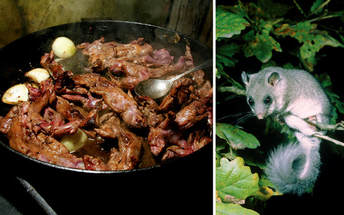 Stuffed Mice There is a protected, fluffy tailed species of dormice (Glis glis or Ghiro) that have been eaten since the days the Caesars ran things. Down in Calabria the rodents are still stuffed and chomped on. They are stuffed with meat, nuts, raisins, onions and spices. You can imagine little squeaks as you take a bite. I have no idea what they do with all those cute fluffy tails. Ghiri alla pizzaiola : Ingredients : . 2 Ghires, 50 g of lard, 50g of pancetta, gr 600 gr peeled tomatoes, 1 tablespoon of chopped parsley, 1 tablespoon of oregano, 1 tablespoon extra virgin olive oil, 1/2 teaspoon of salt Engage the dormice lengthwise, peel them, quickly remove the bladder without breaking it and leave it in running water for a few hours. Rinse them and blanch in boiling water for a couple of minutes. Chop the lard and the bacon and put the mince in the belly of the dormice. Place them in a large pan, pour the oil and cover with chopped tomatoes, parsley and minced garlic, oregano and salt. Cook over moderate heat, keeping the pan tightly closed with the lid. 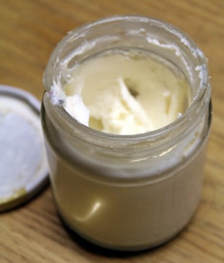 Riccota Forte (or Scanta) The Pugliese are a resourceful bunch. I know--mu Dad was from Puglia. Many of you may know that ricotta means twice cooked or re-cooked... basically, ricotta is a by-product of normal, everyday cheese making. You take the little bit of whey left over, add an acid, boil it and presto, you have ricotta cheese. It's a fresh cheese and should be eaten within a couple of days. When it dries out, the frugal Pugliese add salt, and let it dry even more into Ricotta Salada (one of my favorite cheeses). But some go even further. Some just let it go bad... and stinky... and acrid, turning it into a Apulian delicacy called Ricotta Forte, or Scanta. Many think this acrid, foul smelling cheese is worse than any other stinky cheese they've even eaten--but in a good way. We tried it during our stay in trullo B&B outside of Alberobello. Yes, it stinks, and our host told us how it's just kept in a dark, un-refrigerated place (under his sink) to grow more bacteria and even sometimes microscopic worms--but we actually liked it! (But it did burn my eyes a tad). 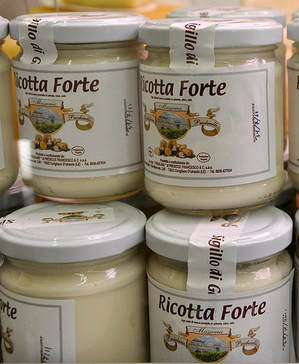 It's the kind of taste that shocks your eyes open, assaults your nose but somehow in the end pleases your palate. It's also a surprise when you are first introduced to it in a plain jar that looks like it's your Aunt's 1950s era home brew face cream. Enjoy. (Oh, just don't get it on anything sweet... I got it on some Nutella and bread by mistake and nearly got whiplash when I popped it in my mouth.) 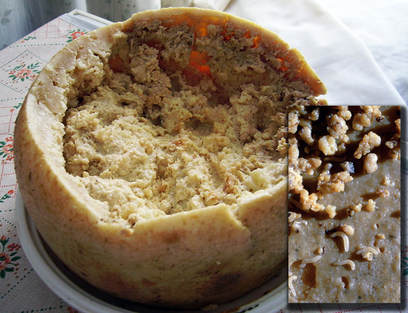 Casu Marzu or Formaggio Marcio (Rotten Cheese), with Maggots Casu Marzu is a sheeps' milk cheese from Sardinia and Corsica (they call it Casgio Merzu) that actually contains maggots--live ones. Most cheeses rely on fermentation and bacteria to develop their flavor, but this cheese relies on actual decomposition caused by the Cheese Fly larvae. The texture is an oozing, seeping liquid, essentially caused by... well... maggot poop. Some people eat this stuff with the larvae, some will tickle the cheese, causing the larvae to be disturbed enough to actually jump out... as much as 6 inches! The daring who have tasted it say this muck is so acidic that it leaves an after taste in your mouth for hours afterward. I recall a cheese like this in France years ago--I wouldn't go near that either! 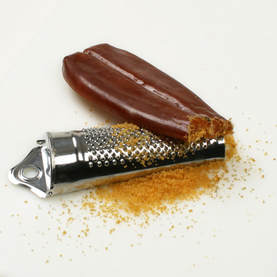 Batarga From what I hear, battarga is definitely an acquired taste that's at least a thousand years old and perhaps more ancient than that. It's made from the roe (fish egg) pouch of either grey mullet or Atlantic blue-fin tuna. The roe pouch is manipulated by hand to get rid of any air bubbles and then cured in sea salt for several weeks. After curing, the result is a hard, dried salty slab which is usually (but not always) coated in beeswax. 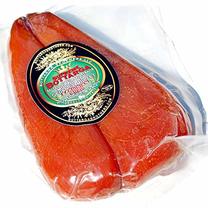 To use it, you grate some on top of pasta or on top of crostini (toasted bread) and drizzled with olive oil. It also can be used as a main ingredient along with garlic for tomato sauce. It has a tremendously long shelf life and is often smuggled out of Italy due to its high price--up to $140 a pound! You can actually order some on AMAZON. 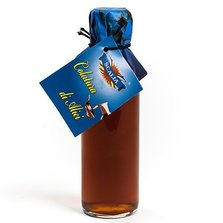 Colatura di Alici, Fish Sauce In ancient Roman times there was a fishy concoction called garum, a clear sauce made from salting and compression of various types of fish. The clear garum on top was used by the upper classes, while the sludge left over, called allec, was used by the lower classes to add flavor to polenta, porridge or on bread. Today there is a modern version called Colatura di Alici made in one of my favorite villages on the Amalfi Coast, Cetera (click the photo to see it on Amazon). The first time I took a tour of Cetera at ground level on Google Earth I started seeing barrels and wondered why this village had so many. It's a fairly simple recipe... 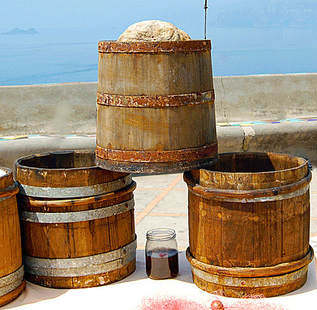
The golden liquid is prized in Italy and is used to flavor all sorts of dishes. Watch the video of Colatura being made... 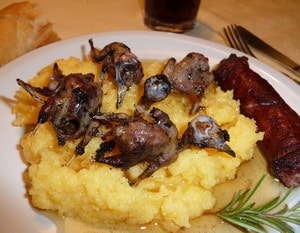 Polenta Uccelli (Polenta with Songbirds, or Polenta e Osei) Yes, the same song birds that will awaken you on a misty Tuscan morning are being shot or captured in hanging nets by hunters to supply their illegal bounty to select restaurants throughout Italy. Yes, it is illegal, but those doing it consider the practice as being furbo (crafty). They make a living while carrying on a tradition. In Tuscany the birds are flambéed, in Sardinia they are boiled and preserved, in the Veneto rolled in pork belly and fried. Perhaps the best known version is in Lombardy where they are grilled or fried. It seems this is an elite recipe item in Italy. Ladies and gents get dressed up in all their finery and make an event out of eating these little skylarks, goldfinches and other types of song birds. Our hot air balloon pilot, Stefano told us they shoot anything in Italy, especially song birds, so much so that some species are becoming endangered. Oddly, we flew directly over some "hunters" in their treetop blind, releasing pigeons only to shoot them a moment or two later. The little tweetys are usually stuffed with pork, beef, rabbit or even other birds. They are served with their heads and beaks on top of polenta, an attempt to mimic a bird's nest. 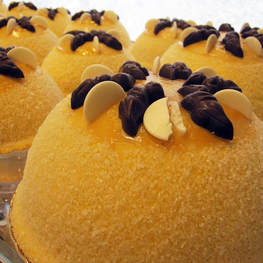 To illustrate how much Italians love this special dish, certain pasticcerie have created a legal version: a dessert called Polenta e Osei, made to look just like the real dish. It's made of a soft light sponge cake filled with hazelnut cream that is rolled in a yellow fondant. On top are little chocolate birds made from chocolate marzipan. You can find this in the town of Bergamo. As for the real song bird dish, the macho thing is to pick up the birdie by the beak and leave nothing... devouring bones, beak and all. At least they are not as ruthless as a similar dish I saw in France years ago--where they drown the birds in the local brandy, then when eating drape a napkin over their heads and the dish to inhale the fragrances and crunch down on the bird, apparently head hidden in shame. 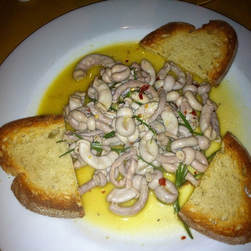 Pajata (Cheese from Cow's Intestines) This is either a Roman dish or what the Devil himself would order up. A young, milk fed (no grass feed) calf is slaughtered, and besides getting veal, brains and other delicacies from it, the intestines are used to make this delicacy--pajata. The intestines are washed, but not emptied. When cooked, the partially-digested milk inside turns into a thick, funky cheesy substance which is used as a pasta sauce, and often served on its own with crostata. No grazie! 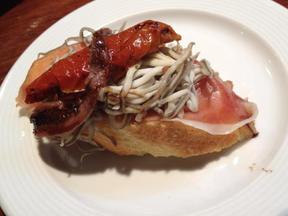 Cieche (Baby eels) Cieche are baby eels that migrate upriver after being born in the sea. The name, Cieche (cieco) literally means blind – these babies have no eyes. In coastal areas of Tuscany, cieche are usually fried or boiled alive. Just be careful they don't jump out when you're trying to dump them into the boiling water or saute pan. 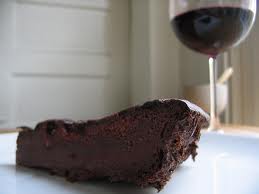 Tuscan Blood Torte Enough said. A torte or cake made from the blood of pigs? I've tried Argentinian blood sausage and British blood sausage, and if the flavor is anything close to what I experienced, I would never go near this stuff. But this recipe contains cocoa and has a chocolate taste, albeit a bit more... er... pungent because of the pig's blood it contains. The pudding used is similar to Sanguinaccio Dolce, a traditional recipe in the South made when a pig is slaughtered using the pig's blood, chocolate, raisins pignoli and sugar. This is an example of the Italian philosophy that nothing goes to waste, not even the last drops of blood. Watch the video below from the Two Greedy Italians series where Gennaro shows how they make the pudding (at 9:45).  Vending Machine Pizza As all of the above proves, Italians will eat anything... even pizza made totally inside a robotic vending machine. Not THAT's a real crime! Let's Pizza machines were initially designed and manufactured in Northern Italy. It offers a choice of four kinds of pies, and makes the pizza while you watch the whole process through windows--adding water to flour, kneading the dough, placing the sauce and toppings, and baking the pizza via infrared oven in just 2.5 minutes. It can produce 90 to 100 pizzas before it needs to be refilled. Ugh. Just because you can, doesn't mean you should! 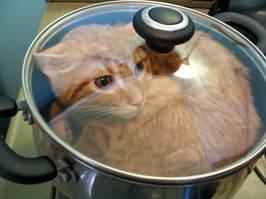 Ok, so vending machine pizza isn't such a big deal, but how about (suspenseful music...) Gatto in Umido? This translates as "Stewed Cat"! Calmati, Betty White... "Gatto in Umido" is simply Stewed Cat-Fish. As I said, we all have to keep an open mind. I hope you enjoyed this look into the traditions of culinary Italy. Via la Cucina Italiana! --Jerry Finzi 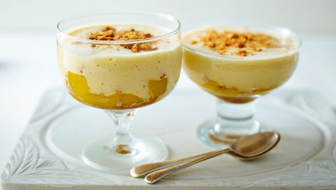 Zabaglione with peaches Zabaglione with peaches Mascarpone: Pronunciation, mas-car-POH-nay A key ingredient in tiramisu and zabaglione, mascarpone is velvety soft, slightly acidic, and expensive. Mascarpone is milky-white in color and is easy to spread. It is used in various Lombardy dishes, and is considered a specialty in the region. Mascarpone originated in the area between Lodi and Abbiategrasso, southwest of Milan, probably in the late 16th or early 17th century. The name more than likely is derived from mascarpa, an unrelated milk product made from the whey of stracchino (a young, barely aged cheese), or from mascarpia, a word in the local dialect for ricotta. Others claims the name comes from the Spanish mas que bueno, "better than good." Ricotta, unlike mascarpone, is also made from whey. Usually sold fresh in tubs, It is one of the main ingredients in the modern Italian dessert known as tiramisu, and is sometimes used instead of butter or Parmesan cheese to thicken and enrich risotto. Mascarpone is also used to produce Italian cheesecakes. It's a highly perishable cheese meant to be consumed as soon as possible after it is made. How to Use Mascarpone
Substitute: Blend 8 ounces softened cream cheese with 1/4 cup whipping cream. Mascarpone is made from two ingredients... whole cream and citric or tartaric acid (to thicken the cream). Click HERE to see how to make your own. Click HERE for Ciao Italia's Italian Cheesecake recipe. --Jerry Finzi  I just wanted to post a quick review of Sliced Bel Gioioso "Fresh" Mozzarella. I don't know what I was thinking when I threw this into my shopping cart. I usually don't buy fresh mozzarella from a supermarket, but instead buy it from a local Italian specialties shop. I actually prefer the dryer packaged skim mozzarella, smoked mozzarella fontina or provolone on my pizzas. To be honest, I didn't even notice that it was pre-sliced--in other words, they charged even more money for them slicing it for you at the factory. Heck, I haven't even bought "Sugar & Cinnamon" in over 30 years, or "thin sliced pork chops" either... I hate paying extra for something that is simple to do at home. Anyway, back to the cheese itself. I think it was two Saturdays ago, I took it out and thought I'd use it to make a classic Pizza Neapolitana. What a mistake. First of all, the slices are way too thick (5/8") to just thrown on a pizza... I trimmed them down using safe knife skills and one of my scalloped chef knives. (Still, this was difficult). Next, the texture was like tofu. Very fake and plastic. The melt happened only toward the end of my 5 minute bake time, and even then I had to put the oven on broil to help them melt down more. As for the taste... well, I wish there was a taste. I've never tasted such a bland mozzarella in my life. It definitely needed salt. Most mozzarella will have up to 200 mg of salt. This one contains less than half that at 85 mg. Fresh mozzarella (the really good stuff) might have salt added at both the curd stage and the hot brine-pulling stage. In the end, the melt on the pizza was not pleasant. It actually cooled down unusually fast and solidified again... the gooey-ness was never really there. So, because of it's plastic texture, the lack of a good melt and the bland flavor, I give it only one out of five Boccas. One final comment: The beautiful sounding "Bel Gioioso" name doesn't quite cut it for a mozzarella made in Wisconsin. It's just a made up marketing name that means "joyful beautiful" in Italian. Sorry. It's neither. --Jerry Finzi |
Archives
May 2024
Categories
All
|

